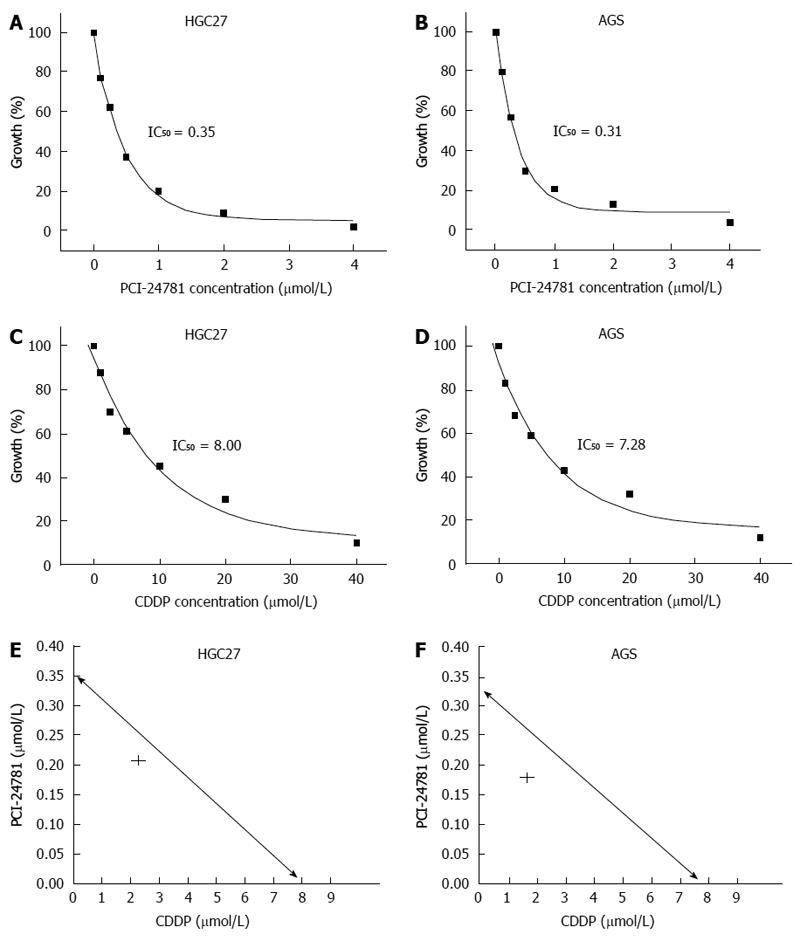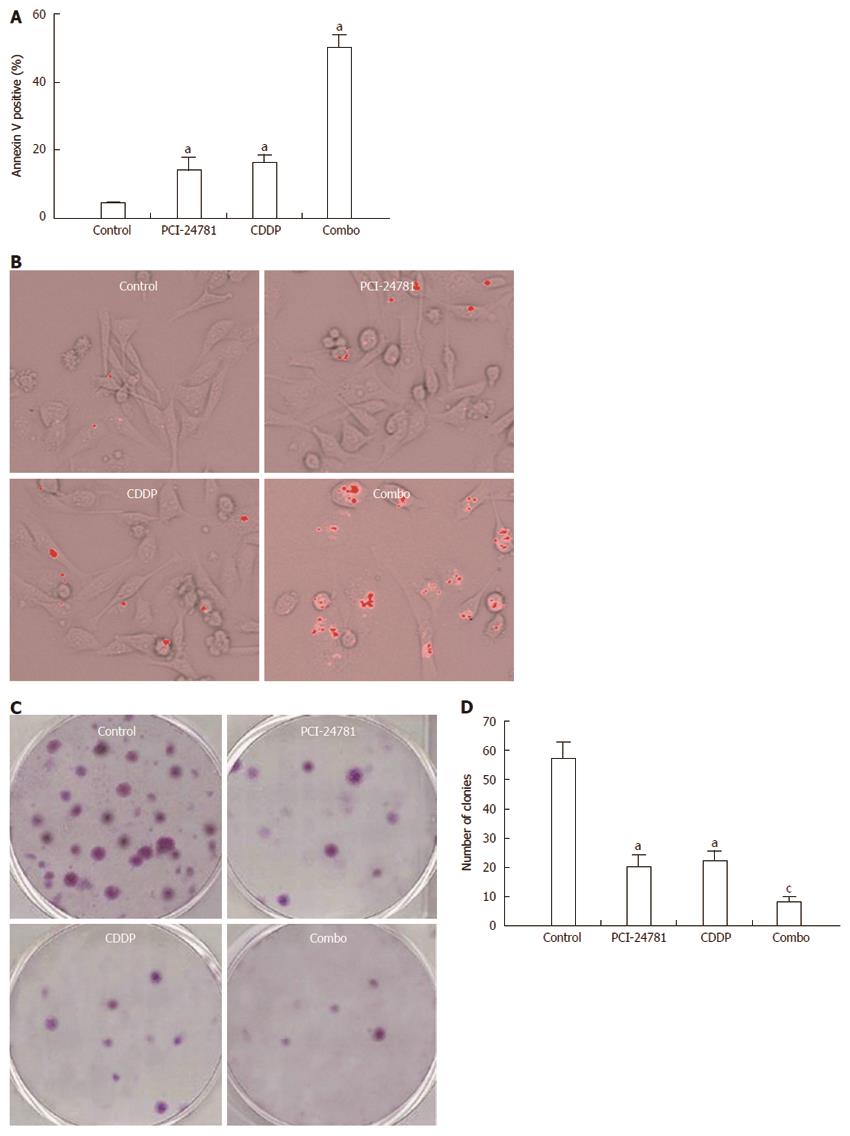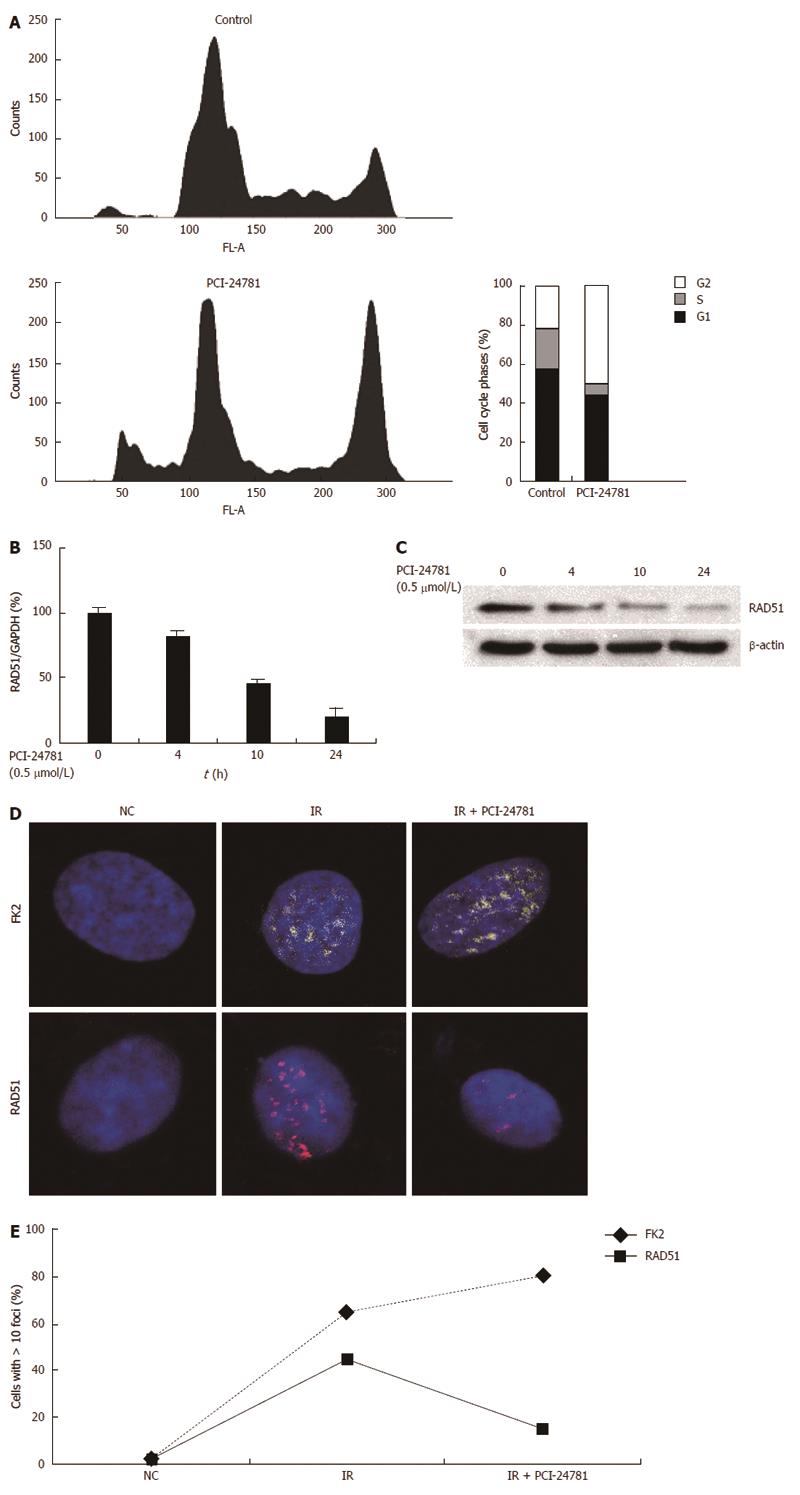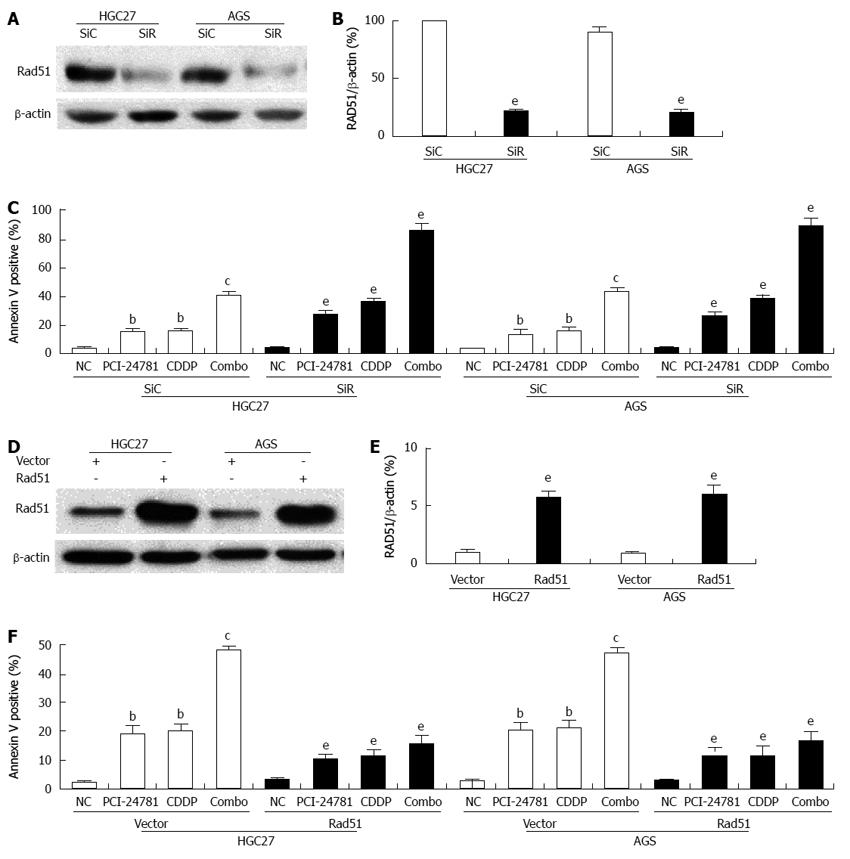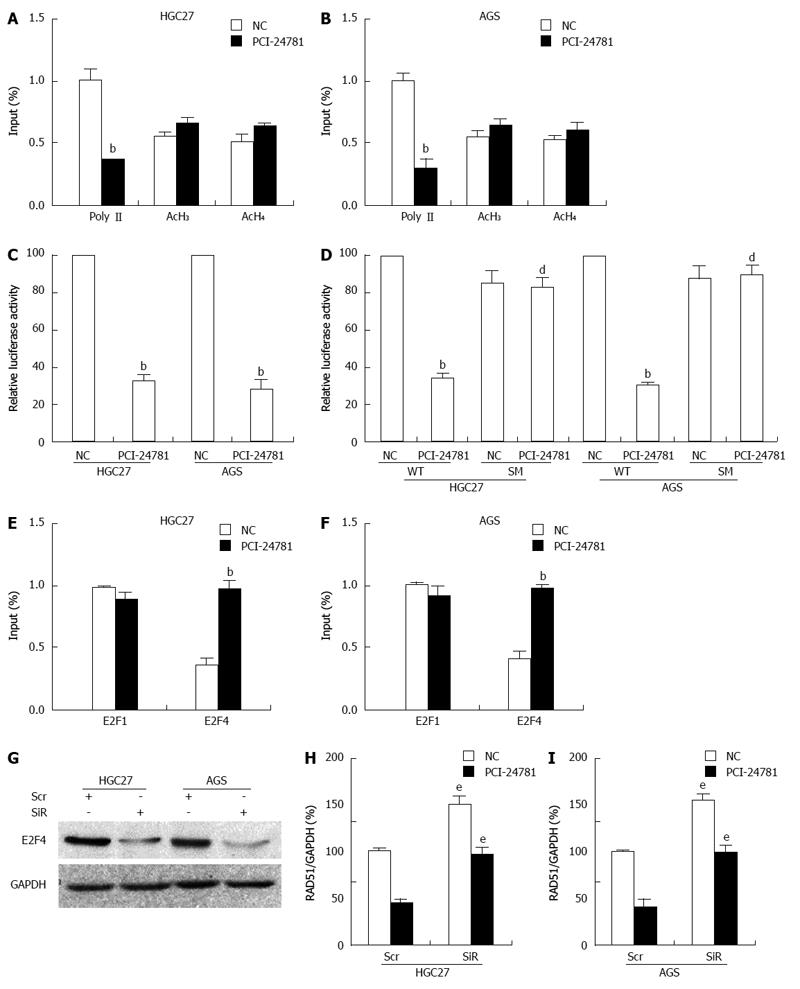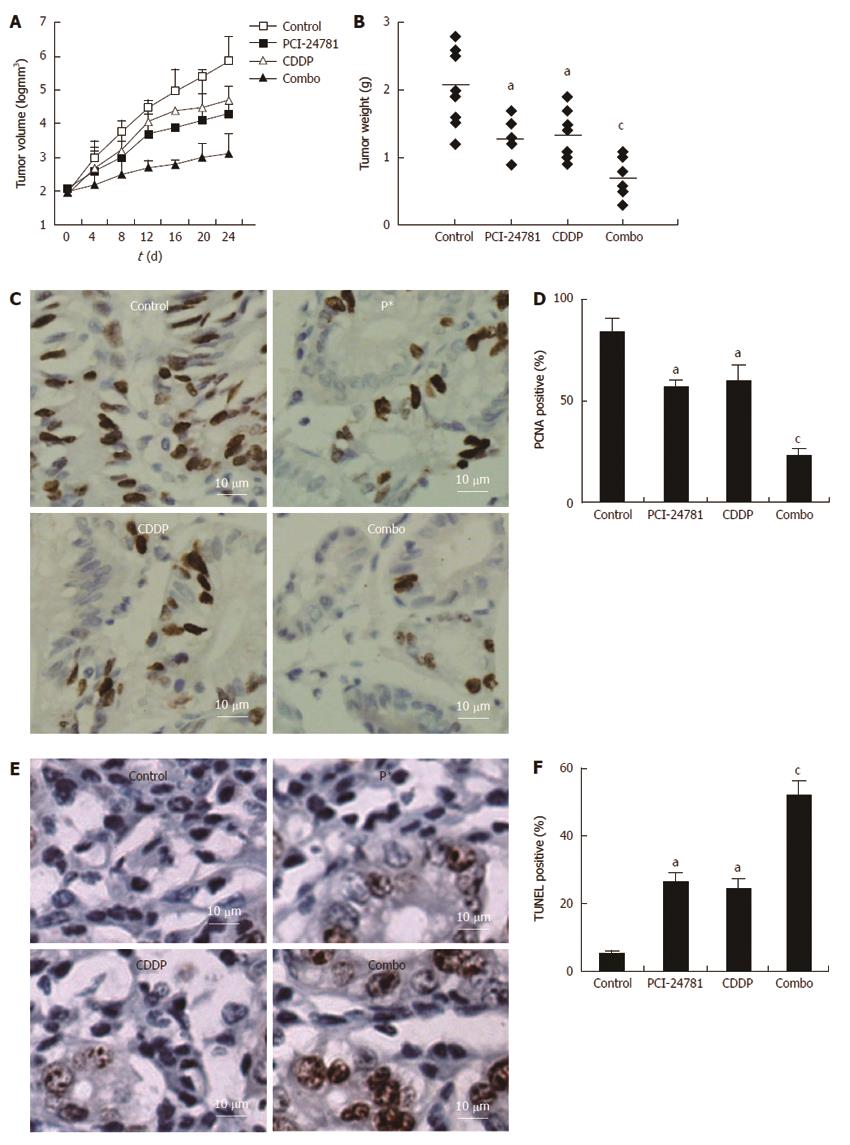Copyright
©2014 Baishideng Publishing Group Inc.
World J Gastroenterol. Aug 7, 2014; 20(29): 10094-10107
Published online Aug 7, 2014. doi: 10.3748/wjg.v20.i29.10094
Published online Aug 7, 2014. doi: 10.3748/wjg.v20.i29.10094
Figure 1 PCI-24781 suppressed gastric cancer cell growth and synergized with the effect of cis-diamminedichloroplatinum.
The gastric cell lines HGC27 and AGS were plated at densities of 2 × 103 cells per well in 96-well plates and were subjected to cell growth assays. The cells were incubated with various concentrations of PCI-24781 and/or cis-diamminedichloroplatinum (CDDP) for 48 h, and the inhibition ratio was determined (IC50). Cell growth assays showed the significant cell growth inhibition of the GC cells in response to PCI-24781 (A, B) and CDDP (C, D) treatment. Isobologram analysis was used to evaluate the synergistic effect. The data point (IC50) from the combination treatment is shown on the left side of the curve and was generated by IC50 of the two drugs; this suggests that the combination treatment (concentration constant ratio PCI-24781:CDDP = 1:10) as synergistic (E, F).
Figure 2 PCI-24781 synergizes with the cis-diamminedichloroplatinum-induced gastric cancer cell apoptosis and clonogenic inhibition.
A, B: After appropriate treatment [PCI-24781, cis-diamminedichloroplatinum (CDDP) and combination] for 48 h, the apoptosis of the HGC27 cells was measured using flow cytometry of annexin V labeled cells (A) and the quantum dot analysis of cleaved caspase-3 (B). The number of apoptotic cells was remarkably increased in the PCI-24781- or CDDP-treated groups, with a synergistic effect in the combination treated group; C, D: PCI-24781 or CDDP partially abrogates the colony formation capacity of the GC cells (10 d). The combination treatment exhibited a synergistic effect. Combo: Combination treatment. aP < 0.05 vs the control; cP < 0.05 vs PCI-24781 or CDDP.
Figure 3 PCI-24781 modulates the genes related to DNA damage and repair.
A: Propidium iodide/fluorescence activated cell sorting analysis showed the effect of the histone deacetylase inhibitor (0.5 μmol/L PCI-24781, 24 h) on HGC27 cell cycle progression. A significant (P < 0.05) reduction in the number of S phase cells and a G2 arrest was observed; The increased sub-G1 population also indicated more apoptotic cells; B, C: Treatment with 0.5 μmol/L PCI-24781 induced a time-dependent decrease in RAD51, both at the mRNA and protein levels; D, E: The confocal laser scanning microscopy immunofluorescence images show HGC27 cells stained with an anti-FK2 antibody (DNA damage marker) and an anti-RAD51 antibody (homologous recombination marker) after pretreatment with 0.1 μmol PCI-24781 for 24 h, followed by 5 Gy irradiation (IR); images were captured 16 h after irradiation. PCI-24781 notably increased the amount of DNA damage-induced ubiquitin conjugation on chromatin (FK2 positive) and suppressed RAD51 foci formation. GAPDH: Glyceraldehyde-3-phosphate dehydrogenase.
Figure 4 RAD51 mediates the effect of PCI-24781.
A, B: siRNA targeting RAD51 dramatically decreased the expression of RAD51; C: Depletion of RAD51 significantly increased the apoptotic cells ratio both in the PCI-24781- and cis-diamminedichloroplatinum (CDDP)-treated cells. A synergistic effect was observed in the combination treatment; D, E: For the overexpression system, human RAD51 cDNA was cloned into pcDNA3.1 to yield the pcDNA-RAD51 plasmid. The empty vector served as a control. The cells transfected with pcDNA-RAD51 showed a notable increase in RAD51 expression; F: Overexpression of RAD51 significantly decreased the apoptotic cells ratio both in the PCI-24781- and CDDP-treated cells. A synergistic effect was observed in the combination treatment. SiC: siRNA-control; SiR: siRNA-RAD51; Combo: Combination treatment. bP < 0.01 vs the control; cP < 0.05 vs PCI-24781 or CDDP; eP < 0.05 vs SiC or vector.
Figure 5 PCI-24781 induces RAD51 transcriptional repression.
A, B: Chromatin immunoprecipitation assays showed a decrease in Polymerase II binding to the transcribed region of the proximal RAD51 gene in gastric cancer (GC) cells in response to treatment with 0.5 μmol/L PCI-24781 for 24 h; binding of acetylated histones 3 and 4 to the RAD51 region was slightly enhanced. No significant nonspecific IgG binding was observed, and input DNA was used as a loading control; C: Luciferase assays demonstrated that treatment with 0.5 μmol/L PCI-24781 for 24 h resulted in the suppression of RAD51 promoter activity; D: Mutation of the E2F binding site located within the first 50 bp of the RAD51 promoter construct abrogated the aforementioned repression; E, F: ChIP analysis showed significantly enhanced E2F4 binding and slightly decreased E2F1 binding to the cis element in the RAD51 promoter in response to PCI-24781 treatment (0.5 μmol/L for 24 h); G: siRNA targeting E2F4 dramatically decreased the expression of E2F4; H, I: Depletion of E2F4 significantly increased the expression of RAD51 and reversed the PCI-24781-induced decrease in RAD51 expression. SM: E2F binding-site mutation; Scr: Scramble siRNA; SiR: siRNA-E2F4. bP < 0.01 vs the control; dP < 0.01 vs wild-type (WT); eP < 0.05 vs Scr.
Figure 6 PCI-24781 synergized with the chemotherapeutic effect of cis-diamminedichloroplatinum in a xenograft model.
A, B: Tumor growth curves showed a significant difference between the PCI-24781- or cis-diamminedichloroplatinum (CDDP)-treated mice and the negative control. PCI-24781 or CDDP also dramatically decreased the tumor weight. The combination treatment obtained the smallest and lightest tumors compared to the single treatment or negative control groups. Immunohistochemical analysis of the GC xenograft specimens demonstrated the significantly decreased tumor proliferation (C, D; PCNA positive) and increased apoptosis (E, F; TUNEL positive) in the PCI-24781- or CDDP-treated tumors, with a synergistic effect in the combination treatment. CDDP: Cis-diamminedichloroplatinum; Combo: Combination treatment. aP < 0.05 vs the control; cP < 0.05 vs PCI-24781 or CDDP. Bar = 10 μm.
-
Citation: He WL, Li YH, Hou WJ, Ke ZF, Chen XL, Lu LY, Cai SR, Song W, Zhang CH, He YL. RAD51 potentiates synergistic effects of chemotherapy with PCI-24781 and
cis -diamminedichloroplatinum on gastric cancer. World J Gastroenterol 2014; 20(29): 10094-10107 - URL: https://www.wjgnet.com/1007-9327/full/v20/i29/10094.htm
- DOI: https://dx.doi.org/10.3748/wjg.v20.i29.10094









